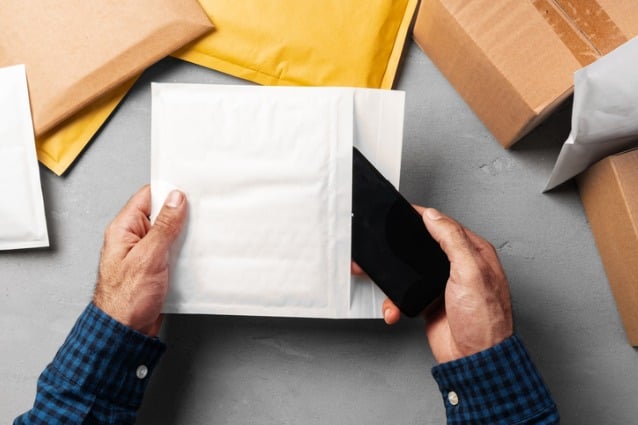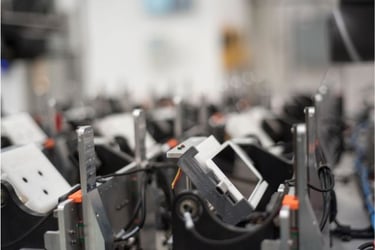Are you looking to offer a trade-in program for your customer’s devices? Perhaps you’re designing what your offering is going to be. You can’t start your program without knowing where and how customers will be able to access it! The chances are that you’ll be considering online and in-store trade-ins.
Understanding the needs and wants of your target audience will define many parameters for your trade-in. Missing the mark will hinder your success and waste the costs you’ve invested in starting the program.
Ingram Micro Lifecycle works with most UK network operators, including Three, O2, and giffgaff, supporting their trade-in programs.
Below, we discuss the advantages and disadvantages of in-store and online trade-in. We'll reveal which is the better option for your business.
The trend towards trade-in
Attitudes towards refurbished and pre-owned devices are changing. Demand is increasing and trade-in programs are a great source of stock.
Ahead of resale, you have the opportunity to maximize the value of these traded-in devices via:
- repair
- refurbishment
- cosmetic polishing
- grade uplift
- re-kitting
- repackaging
These devices could also go to economically developing countries where buying brand-new devices is not a feasible option. The repaired secondary devices provide a cost-effective alternative.
One in five people in the UK had traded-in items for upgrades or cash alternatives in the last six months. This was a 26% increase compared to the same period prior and a 72% increase from the year before. Mobile phones were the most popular product (39%), ahead of cars, DVDs, clothes, and video games.
There are green messages you can include in your campaign, as by recovering products through trade-in to resell or recycle, you’re promoting a circular economy. These products won’t head to the landfill as e-waste, and any beyond economic repair can be sustainably recycled.
As a sales enablement tool, it can help boost brand loyalty and customer retention while giving you the opportunity to increase your market share and build your customer database.
Pros & cons of in-store programs
These programs operate out of a physical location, such as a retail store. Customers must visit the premises to engage with the program.
Advantages
Customers must bring the device they’re looking to trade-in into the store. This means you can look at and touch what you’ll be buying. Through your simple assessment questionnaire, you can make a better valuation based on the quality and damage of the device.
The customer will have realistic expectations of what they’ll receive for their product. They’ll be more satisfied with the experience, and their brand loyalty will increase.
The logistics are more environmentally friendly. The customer is likely to be on the high street or in-store for some other reason and can trade in their phone at the same time. The fact that the devices are all consolidated in the store and sent in a single journey with other returns and repairs is also a carbon saving.
There are financial savings too as the postage cost of obtaining the product is avoided.
Disadvantages
Once your in-store trade-in program is up and running, your staff will need training to operate it. This takes time to ensure they can communicate the offering effectively. Fraudulent activity may occur, so effective governance and monitoring are key.
Staff could make an honest mistake in their valuation of the goods. Lack of experience or access to appropriate information could mean they price the product too high or too low.
Intentionally under-valuing goods would damage your brand reputation and integrity, turn away customers, and hit your finances. Training your staff is imperative to ensure they follow hard to ‘bend’ processes.
The opening hours of your facility restrict your in-store program. Customers can only engage with your trade-in opportunity when you’re physically open. This either reduces your target audience or leads to what could be considered unsociable hours for your staff to work.
Learn more: 8 Pitfalls of Consumer-Facing Trade-In Programs & How to Avoid Them
Pros & cons of online trade-in programs
These solutions will be white-label, custom-built, or integrated via API into your current website.
Customers can visit online, complete an assessment of their device, and send it to you.
Advantages
There are fewer time restrictions. Customers can visit your website to begin the trade-in process at any time of day, regardless of whether your store is open or not. You don’t need staff to be available to assist with the process.
Accessibility to valuations poses less of a physical problem. Customers don’t have to travel specifically to get their devices valued. Instead, they can do it from the comfort of their home, from work, or even on their commute.
Some people prefer to do their transactions online, with less interaction or intervention.
Online solutions give you great flexibility. You can make instant changes to the site, including pricing, offers, and products, at any time of day or night.
Disadvantages
Not all your potential customers or target audience may be able to get online. A technological divide still exists in some communities. Not all can afford or have the means to access the internet.
Some people may not want to use the internet. Some people will always favor talking to a real person, just as some would prefer not to.
Distractions can affect the conversion rate. The customer could forget or make a different decision; both mean they fail to check out and finish the transaction.
Will you choose online or in-store?
Both routes present an upsell opportunity when customers discuss buying a new device from you.
It closes the circle as the customer probably no longer has a need or use for the older device. You can highlight the sustainability benefits to the customer by reducing their e-waste and ensuring the device lifecycle is extended.
All the factors above need to be considered when designing your trade-in program. You need to mitigate against the disadvantages and capitalize on the advantages.
Ultimately, neither is better than the other. The customer must come first for the process to be as simple as possible to gain the highest number of conversions. It’s unlikely that you can say, “My customer definitely won’t want an online option,” or “I won’t ever receive any interest in an in-store program.”
You need to cater for everyone, and that means offering both online and in-store trade-ins. The real benefit comes from where you can stitch together separate transactions and experiences to make one single, seamless journey.
Ingram Micro Lifecycle is an experienced partner for trade-in programs. We work with most UK network operators and other retailers supporting their trade-in programs. Reach out to our team today to discuss how we can support you.
Want to read more about what happens to traded-in devices? Check out these related articles.














